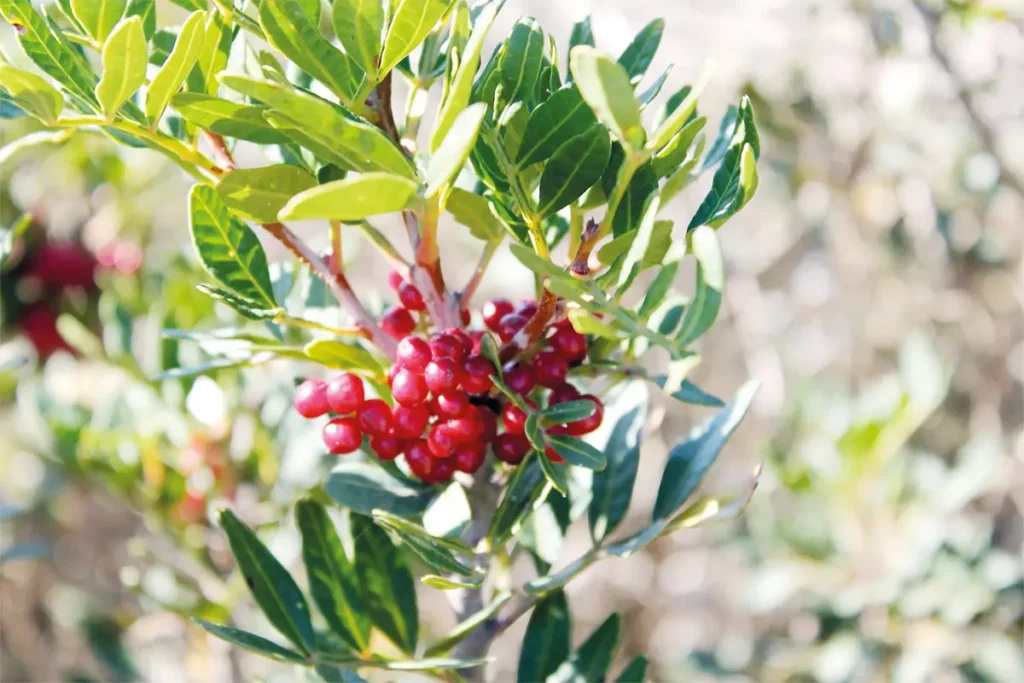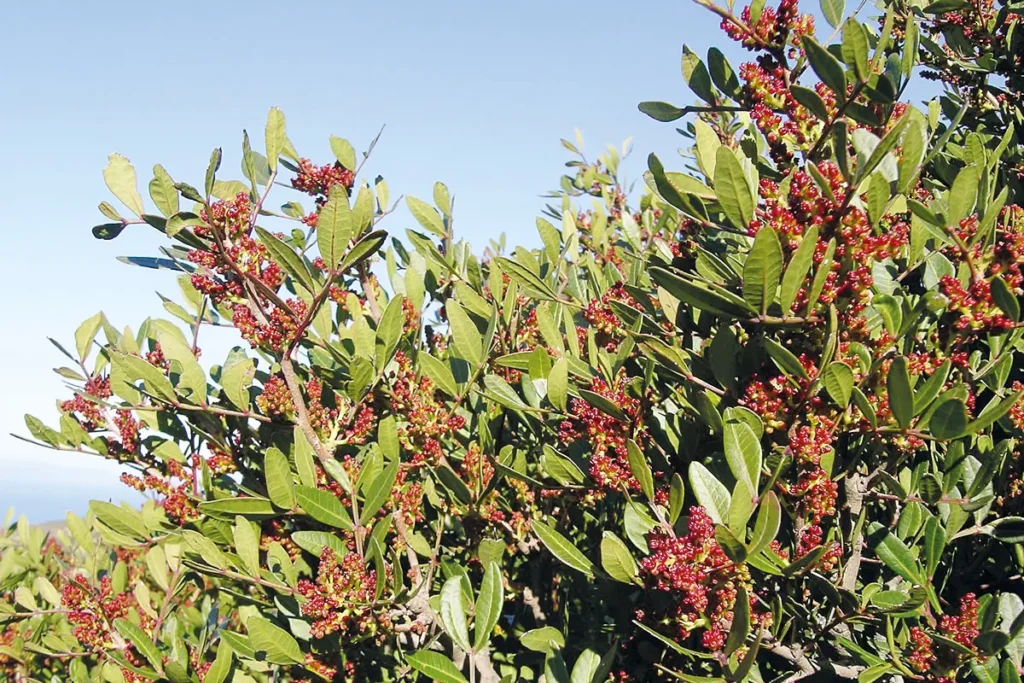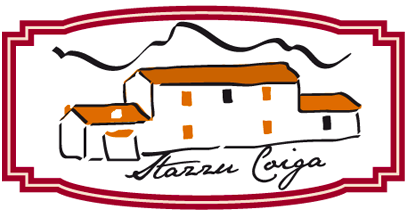


Nome Italiano: Lentisco
Nome scientifico: Pistacia lentiscus L.
Nome Gallurese: Chessa
Descrizione:
Specie indigena tipica della macchia mediterranea. Arbusto o alberello sempreverde diffuso in tutta la Sardegna. Pianta in genere ricca di polloni con portamento arbustivo, o spesso a pulvino o a portamento arboreo raggiungendo dimensioni considerevoli. Foglie paripennate e persistenti, con pagina superiore liscia e lucida; pagina inferiore più chiara e ruvida che se stropicciata emana un forte odore di resina. Nelle fasce costiere della Gallura vegetano alberi maestosi che costituiscono dei monumenti naturali e paesaggistici, con dimensioni straordinarie anche di circa 70-80 cm di diametro.
Proprietà e usi:
Caratteristica interessante di questa pianta, è l’essudazione di una resina oleosa dal suo tronco che viene impiegata in campo fitoterapico utilizzata anche nella produzione di chewing-gum. La resina di lentisco ha impiego in fitocomplessi preparati contro le infiammazioni del tratto gastrico da reflusso per proteggere le cellule dello stomaco. Come antisettico, disinfettante e antibatterico, trova impiego nelle affezioni del cavo orale e come eudermico, possiede proprietà lenitive, riequilibranti e rigeneranti, adatto per le pelli sensibili affette da dermatiti.
Curiosità e miti:
In passato il legname di lentisco era molto ricercato per la produzione di carbone, portando alla dissipazione di vaste aree di alberi secolari. L’olio di lentisco in Sardegna era utilizzato fin dai tempi dei nuraghi a scopi alimentari al posto dell’olio d’oliva. “Siamo il regno ininterrotto del lentisco”, declamava Grazie Deledda nella poesia Noi siamo sardi. Pianta dai poteri scaramantici, teneva lontano il malocchio. Con le foglie si confezionavano amuleti da appuntare sugli indumenti dei bambini. Una leggenda racconta di Sant’Isidoro che dopo la conversione al cristianesimo dovette rifugiare nell’isola di Kios, dove morì in solitudine con la sola compagnia di un arbusto di lentisco, che dopo la sia morte la pianta lacrimava resina lattiginosa.

Italian name: Lentisco
Scientific name: Pistacia lentiscus L.
Gallurese name: Chessa
Description:
Indigenous species typical of the Mediterranean maquis. Shrub or evergreen sapling widespread throughout Sardinia. Plant usually rich in suckers with shrubby habit, or often pulvinus or arboreal habit reaching considerable size. Leaves are paripinnate and persistent, with a smooth, glossy upper page; the lower page is paler and rougher, giving off a strong resinous odour when crumpled. In the coastal areas of Gallura, majestic trees vegetate that constitute natural and landscape monuments, with extraordinary dimensions of even around 70-80 cm in diameter.
Properties and uses:
An interesting feature of this plant is the exudation of an oily resin from its trunk, which is also used in phytotherapy in the production of chewing gum. Lentisk resin is used in phytocomplexes prepared against inflammation of the gastric reflux tract to protect stomach cells. As an antiseptic, disinfectant and antibacterial, it is used in oral cavity ailments and as an eudermic, it has soothing, balancing and regenerating properties, suitable for sensitive skin affected by dermatitis.
Curiosities and myths:
In the past, mastic wood was much sought after for charcoal production, leading to the dissipation of vast areas of centuries-old trees. Lentisk oil in Sardinia was used since Nuragic times for food instead of olive oil. ‘We are the uninterrupted kingdom of the mastic tree’, declaimed Grazie Deledda in the poem Noi siamo sardi. A plant with superstitious powers, it kept away the evil eye. The leaves were used to make amulets to pin on children’s clothing. A legend tells of Saint Isidore who, after his conversion to Christianity, had to take refuge on the island of Kios, where he died in solitude with only the company of a mastic bush, which, after his death, the plant wept milky resin.
